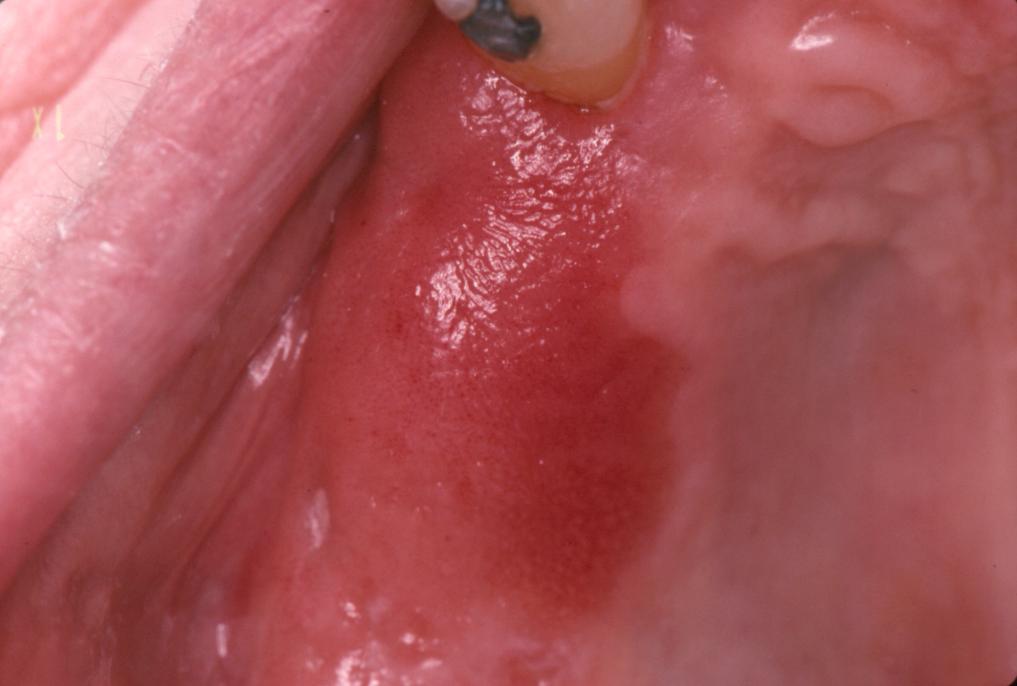Erythroplakia / Erythroplasia
Erythroplakia (Greek, “flat red area”) is defined as a fiery red patch that cannot be characterised either clinically or pathologically as any other definable lesion.
These may appear as a bright red, smooth, velvety, granular or nodular lesions often with a well-defined margins adjacent to normal looking mucosa and are usually asymptomatic.
The soft palate, the floor of mouth, the ventral surface of tongue and the retro-molar area are the most common sites of involvement.
Erythroplakia is more common among middle aged to elderly persons and, especially among men. It is less common than leukoplakia.
The prevalence of these lesions range from 0.02 – 0.83% in different regions.
Ætiology
The risk factors for erythroplakia are the same as for oral squamous cell carcinoma.
Diagnosis
Erythroplakia is seldom multi-centric and rarely covers extensive areas of the mouth. It is soft on palpation and does not become indurated until an invasive carcinoma develops in it.
It is often asymptomatic, although some patients may complain of a sore, burning or metallic sensation.
Oral erythroplakia has the highest risk of malignant transformation compared to all other mucosal lesions ie Most potentially malignant of all oral mucosal lesions.
All erythroplakias should be viewed with extreme clinical suspicion for malignancy, as they are more likely to harbour histological foci of severe dysplasia, carcinoma in-situ (CIS) or micro-invasive cancer.
The incidence of severe dysplasia or carcinoma in these lesions is very high (80 – 90%) and biopsy is mandatory. Areas of erythroplakia may also co-exist with leukoplakia in so-called “mixed” or “speckled” lesions (erythro-leukoplakia).
Care must be taken to obtain a representative biopsy specimen in such cases, with sampling of multiple areas within the lesion, as carcinoma may be present only focally.
It appears as a usually asymptomatic, fiery red, well demarcated plaque, with a smooth and velvety surface, usually level / depressed with surrounding mucosa. The red lesions may be associated with white spots or small plaques.
The floor of the mouth, retro-molar area, soft palate, and tongue are the most common sites of involvement.
Erythroplakias occurs more frequently between the ages of 50 and 70 years.
Laboratory Tests
Histo-pathological examination.
Differential Diagnosis
The following conditions should be considered before making a diagnosis of erythroplakia:
- Local irritation
- Early squamous cell carcinoma
- Invasive oral cancer
- Discoid lupus erythematous
- Lupus erythematosus
- Non-homogeneous leukoplakia
- Erosive lichen planus
- Acute atrophic candidiasis
- Erythematous candidiasis
- Denture induced stomatitis
- Pemphigus
- Hæmangioma
Management / Treatment
Management of oral erythroplakia focuses on the prevention of malignant transformation and early detection of occult malignancy.
Persons with erythroplakia should be advised to stop tobacco / alcohol habits and should be encouraged to take a diet rich in vegetables and fruits (anti-oxidants).
In view of the high malignant potential of these lesions, the recommended treatment is surgical excision, including laser. However, even after surgical excision, the recurrences and development of malignancy at the same site are high. In view of this, long-term follow-up is essential even after surgical removal.
Useful Articles & Websites
International Agency for Research on Cancer / World Health Organisation
CA Cancer J Clin 2002. Oral Cancer and Pre-cancerous Lesions
Oral Oncology 2004. Oral Erythroplakia – A Review
Red & Mixed Red-White Lesions. Clinical Stomatology Conference. September 2007
ENT News 2008 – What is the Risk of a Red or White Lesions in the Mouth Being Malignant?
MJA 2009. Clinical Update. Oral White Lesions – Pitfalls of Diagnosis
Head Neck 2009. Treatment & Follow-up of Oral Dysplasia – A Systematic Review & Meta Analysis


